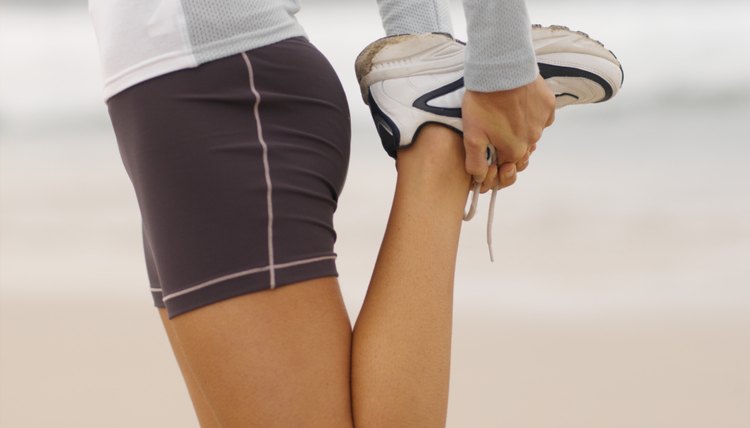Difference Between Hip Flexor Stretch & Quad Stretch

Many muscle groups in your body work in concert to create fluid movement. When you walk or run, your hip flexor muscles draw your leg toward your torso as you lift your foot up. Just after this movement, your quad muscles work to extend your leg, straightening the knee joint as you step forward. You can stretch both of these muscle groups with similar positioning; the difference is in the alignment of your pelvis.
Hip Flexor Muscles
The term "hip flexor" describes the action of this muscle group, since the two muscles here literally flex your hip joint. Your doctor might also use the anatomical terms "iliacus" and "psoas major." The iliacus runs from the top of your pelvis to the midpoint of your thighbone. The psoas runs from your low-back vertebrae to about halfway down your thighbone. A tight psoas is a common cause of minor low-back pain.
Hip Flexor Stretch
A productive hip flexor stretch relies on using the scooped-pelvis position, which you might experience in a yoga class that includes the single-leg apanasana pose. Practitioners lie flat on a mat with legs extended and then tuck one knee in toward their chest for up to five minutes before switching sides. Advanced practitioners can add a yoga block under their hips to increase the tilt of the pelvis. The key to both poses is flattening the low back to achieve maximum pull on the hip flexors.
Quadriceps Muscles
Most people refer to the four muscles that open the knee joint as our quadriceps, or "quads." A medical professional might refer to them as "rectus femoris," "vastus medialis," "vastus intermedius" and "vastus lateralis." All four sit on the front of your thigh. The vastus muscles attach your thigh bone to your shin, while rectus femoris runs from the edge of the pelvis to the shin.
Quadriceps Stretch
Since the quads sit lower on the thigh than the hip flexors, tilting the pelvis or arching the low back can shift the biomechanics of the stretch. Triathletes use the runner’s lunge stretch to achieve this position. Kneel upright on a mat and step one foot forward. Gently press the back knee down, creating space between the back knee and the waistband. Experienced athletes allow the spine to gently arch, tilting the tailbone back. When compared to the hip flexor stretch, the pelvis should tilt in the opposite direction to allow the quad muscles to fully lengthen.
References
Resources
Writer Bio
This article was written by the CareerTrend team, copy edited and fact checked through a multi-point auditing system, in efforts to ensure our readers only receive the best information. To submit your questions or ideas, or to simply learn more about CareerTrend, contact us [here](http://careertrend.com/about-us).
